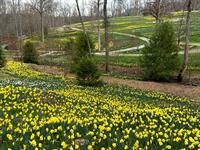VOTE for Daffodil Festival at Gibbs Gardens 2025's Best Flower Festival!
VOTE HERE!!
Vote for Daffodil Festival at Gibbs Gardens as 2025's Best Flower Festival
Gibbs Gardens opens March 1 as millions of daffodils usher in spring
Forget the calendar. Spring starts March 1 when Gibbs Gardens’ millions of daffodil blooms draw visitors from around the globe to experience this spectacular event.
Recently named, one of “The World’s 10 Best Places to see Daffodils,” by Flower Magazine, the article noted, “Gibbs Gardens offers the country’s largest daffodil extravaganza.” Southern Living described Gibbs Gardens as “The largest display of daffodils outside of Holland.”
Each year Jim Gibbs, the owner, designer and developer of Gibbs Gardens, patiently checks the weather, calendar—and, most importantly, the daffodils—to determine when millions of blossoms will begin to burst forth in his daffodil gardens.
“It is a joy to welcome our members and visitors to Gibbs Gardens for our 12th year,” said Gibbs. “There’s something about daffodils ‘announcing’ spring that brings smiles and evokes happy memories of sunny days.
“Our visitors always have lots of questions about the daffodils—how we plant them and create these unique designs,” he added.
Daffodils don’t check the calendar
The 20-plus million daffodils—representing more than a100 varieties planted in Gibbs Gardens—each have their own variety blooming schedule. The season begins (based on each winter’s weather) with early blooming varieties followed every two weeks by later varieties to provide a six- to eight-week blooming season. All of Jim Gibbs’ planning, planting and design depends upon the date and order his daffodils bloom.
One hundred acres of Gibbs Gardens’ vast 376-acre property is dedicated each year to daffodils. In 1985, Gibbs started planting hundreds of thousands of perennial daffodil bulbs each year. Perennial bulbs divide every season, exponentially increasing the number of blooms from year to year.
“In November 2022 we planted more than 577,000 bulbs—the largest number ever in one year,” he said.
Gibbs approaches his daffodil gardens with the same dedication great artists apply to their works of art. He reviews the topography of this 50-acre garden, noting the angles of the land, vertical accents, curves of the hillsides, shaded and wooded areas, direction and hours of sunlight, nearby streams/water venues and walkable paths for his members and visitors. Every element contributes to his final planting design.
Over the river and though the streams
Gibbs’ daffodil gardens feature two side-by-side hillsides, each flowing down to a valley adjoining his Valley Gardens. He plants daffodils along each hillside to create a “stream” of daffodils. Each hillside stream is vertically divided into separate, narrower streams based on the color and bloom time of the daffodil varieties. Using four daffodil bulbs per square foot, every group—early, early/mid, mid, mid/late and late—is planted in its own separate stream based on bloom time.
Streams of daffodils—ranging from 5 to10 feet wide—in subtle shades of yellow, gold, white, pink and orange flow and curve down each hillside then blend together to create a river of daffodils in the valley. This breathtaking vista is a one-of-a-kind garden experience.
“The different elevations are more attractive than looking at a flat surface and provide interesting contrasts with vertical accents. This year we added 100 new cherry trees for visual interest,” said Gibbs. “Part of North Georgia’s attraction is its beautiful topography.”
Advice for home gardeners
For home gardeners Gibbs offers this advice when planning where to plant daffodils. “Always plant the late blooming bulbs in the front, the mid-season in the middle and the early bloomers in the back,” he said. “That way the focal point of your gardens will always be the blooming daffodil flowers in front, not those with spent blooms.”
He also recommends finding sunny spots for planting.
“Daffodils love full sun; the plants need four hours of sun a day for at least six weeks. This helps each plant create new blooms for the following year.”
For home gardeners who want cut flowers for their homes, he recommends buying a mix of perennial daffodil bulbs to extend the blooming season for cut daffodils. Gibbs Gardens has naturalized perennial mix bulbs for sale.
Gibbs reminds garden visitors there will be more than daffodils to see in March. The new Inspiration Garden has 215 species of dwarf conifers on display and the four-season Japanese Gardens offers beautiful vistas year-round.
Named one of the world’s best places to see daffodils by Flower Magazine, one of the Thirteen Best Botanical Gardens in America, a top garden in Georgia by the Atlanta Journal Constitution and Explore Georgia, Gibbs Gardens always has something new in bloom. The five feature gardens and 21 seasonal collections gardens offer unique and continuous delights for garden lovers of all interests. To learn more about Gibbs Gardens go to gibbsgardens.com.
Images: 4 hi res images; more available if needed. Photo credit: Gibbs Gardens
- As far as the eye can see, millions of daffodils sprawl across Gibbs Gardens’ hillsides and fields.
- Gibbs’ daffodil gardens feature two side-by-side hillsides, each flowing down to a valley. He plants daffodils along each hillside to create a “stream” of daffodils.
- Streams of daffodils—ranging from 5 to10 feet wide—in subtle shades of yellow, gold, white, pink and orange flow and curve down each hillside then blend together to create a river of daffodils in the valley.
- This breathtaking vista—millions of daffodil blossoms—creates an unforgettable, one-of-a-kind garden experience.
Gibbs Gardens
-
Barbara Schneider Media Relations
- February 18, 2025
- (770) 893-1880
- Send Email

